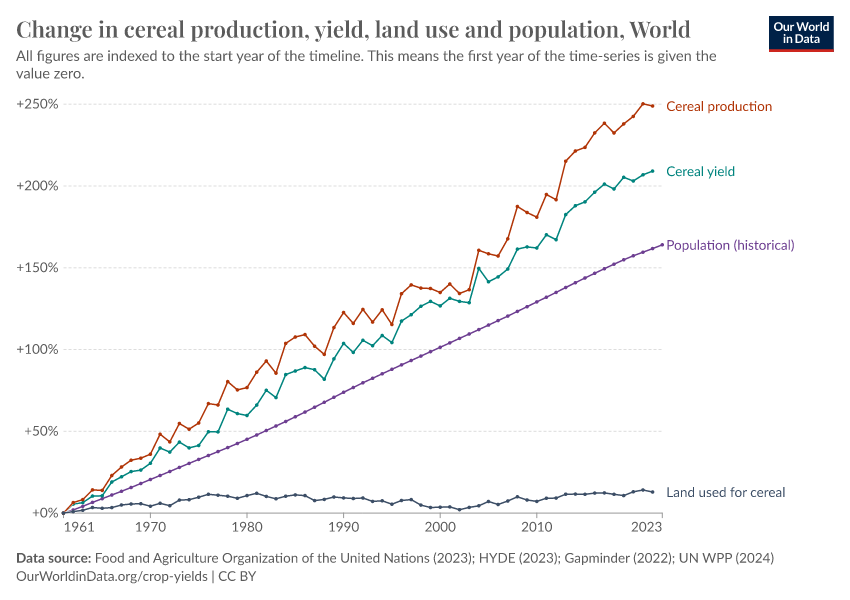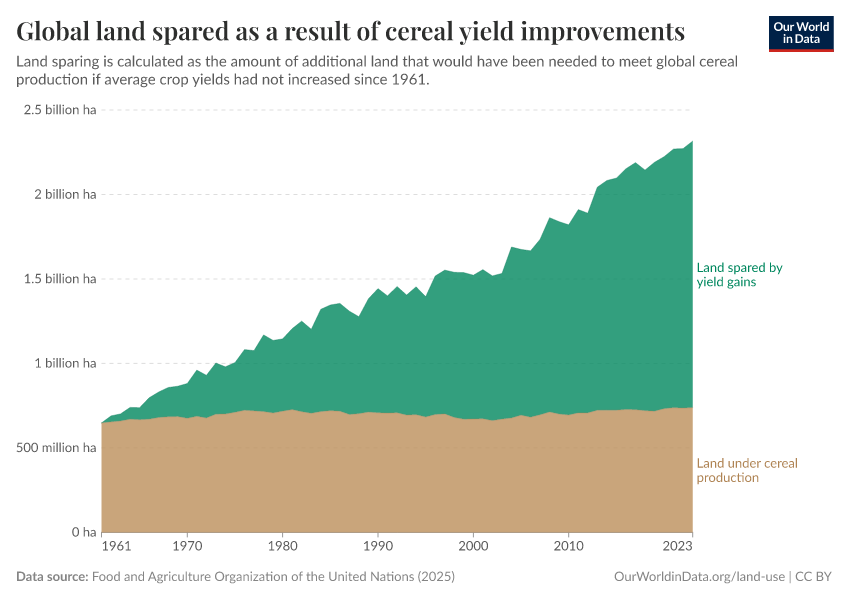Yields vs. land use: how the Green Revolution enabled us to feed a growing population
Over the last 50 years, the global population has more than doubled. This factor has inevitably reduced the land available per person to live and grow food. How have we managed to feed a rapidly growing population with ever-shrinking land resources?
There are two key variables we can change to produce more food crops. We can opt for:
- Expansion: increase the area of land we grow our food over
- Intensification: increase the yield output (i.e. kilograms of crop produced per unit area of land). This is typically achieved through a combination of chemical inputs (such as fertilizer, pesticides and herbicides); improved water use (e.g. irrigation); mechanization and improved farming practices; and the use of higher-yielding crop strains or seeds
Global cereal production
At the global level, how has crop production changed over the last fifty years? Here, we focus on cereal production: cereals form the base component of energy intake in most diets, comprising more than half of total caloric intake in many countries, and also dominate global arable land use by area.
In the chart below we have mapped four variables: total cereal production; average cereal yield; land area used for cereal production; and total population. These are measured as an index relative to their respective values in 1961 (i.e. 1961 is equal to 0).
We see that global cereal production has grown at a much faster rate than the population. That means that cereal production per person has increased despite a growing population.
Have we achieved this through land expansion or improved yields? As we can see in the chart, expansion played a very small role: over the last few decades land use for cereal production has increased only marginally. Overall, this means we use less land per person than we did fifty years ago.
Most of our improvements in cereal production have arisen from improvements in yield. Today, the world can produce almost three times as much cereal from a given area of land than it did in 1961. As we will explain below, this increase has been even more dramatic in particular regions.
Although food is globally traded, the relative distribution of food production is crucial to food security. The evolution of these trends at national and regional levels is therefore critical. Below we have explored a number of varied and interesting examples of these trends across the world. The change in cereal production, population growth, and the relative contribution of yield gains and land expansion are different in each.
The Green Revolutionaries: Mexico, India, China, and Brazil
One of the most critical turning points for global agriculture was the so-called ‘Green Revolution’, which began in the mid-20th century. The Green Revolution is used to describe the large-scale transfer and adoption of new technologies in the agricultural sector, particularly in the developing world. These technologies included chemical inputs (such as fertilizers and pesticides), irrigation technologies, farm mechanization (such as tractors), and high-yielding rice, wheat and maize seed varieties. Overall, this led to a significant shift in agriculture from ‘traditional’ to ‘industrial’ practices across the developing world. However, progress and adoption has not been equal across countries.
Mexico
In the chart below we see cereal production, land use and yield trends for Mexico over the period from 1961. Mexico was one of the first countries to be linked to the Green Revolution of the 20th century.1
As we can see, the increase in cereal production in Mexico has greatly exceeded population growth. Again, this means cereal production per person has increased.
And while agricultural expansion has played some role in this, the adoption of advanced agricultural technologies and practices has led to impressive gains in yield.
India
In the chart below we see the evolution of India’s agricultural system since 1961. In the 1960s and the decades which followed, India also underwent a Green Revolution in agricultural production and reform. In order to address recurring cycles of severe famine under British rule in the 18th, 19th and first half of the 20th century, independent India made large economic, technological and social investments in improved agricultural practices—particularly in wheat and rice crops.2
The adoption of higher-yielding cereal varieties, subsidization of fertilizer and irrigation inputs, and investments in agricultural research and development all led to rapid gains in cereal yield.3
Shown below, we see that since around 1970, cereal output has grown at a faster rate than India’s population. In contrast to Mexico, this increase in production has been achieved almost completely through agricultural intensification and yield improvements. Throughout this period, the total area of land used for cereal production barely changed. This reduction in area needed per person is particularly important for countries like India, where the total population continues to increase.
China
China’s transition has several parallels to that of India. China has managed to achieve an impressive increase in cereal output with almost no expansion of area used for cereal production. As a result, the share of China's population who are undernourished has fallen significantly.
This growth is almost entirely attributable to improvements in productivity and yield. It has, however, achieved a much greater gap than India in cereal output relative to population (the increase in per capita cereal production, and caloric supply has been much more dramatic).
What is this additional cereal crop used for? Per capita caloric supply in China has more than doubled over the last 50 years, but less than half is used for direct human consumption. Large quantities is used for animal feed, with some additional cereals used for industry, such as biofuels.
Brazil
Brazil’s cereal production has increased dramatically since 1961, far exceeding its population increase.
Unlike India and China, Brazil has achieved this through a combination of both yield improvements and land use expansion. It thus provides a perfect example of the trade-off between extensification and intensification. Over the 1960s and 1970s, Brazil’s land area under cereal production almost doubled—this correlates with a 20-year period of almost stagnant cereal yields. This expansion has been of particular concern from an environmental perspective, with the expansion of agriculture often happening at the expense of forested areas and ecologically important regions such as the Amazon.4
From 1980 onwards, however, we see the inverse of this relationship. Since 1980, cereal yields have increased dramatically. This development aptly highlights the transition from extensification (low yields, large area expansion) in the 1960s and 1970s to intensification (increasing yields, constant land use) from 1980 onwards.
Sub-Saharan Africa
The adoption and success of the Green Revolution has not been consistent across the developing world. Africa – particularly Sub-Saharan Africa – has been a region of particular concern in terms of food security. Despite making significant progress in reducing hunger in recent decades, undernourishment in Sub-Saharan Africa remains the highest in the world.
Africa's cereal production has struggled to keep pace with population growth. Despite an increase in cereal output of around 300 percent, per capita output has been declining. Overall, we see much greater emphasis on agricultural expansion. Relative to Asia and Latin America, the region’s improvements in yield have been much more modest.
United States
Since 1961, the US’s population has been growing modestly. Cereal production grown much faster. Overall, we see that land allocated to cereal production in the United States has actually declined slightly.
Like China, while some of this additional output is consumed by humans,5 most of it is diverted to other uses – mostly biofuels and animal feed.
Germany
Here we use Germany as a representative of a high income country with a stable population size—in this regard, its trends are similar to many countries across Europe. Below we see that despite a roughly constant population size, Germany’s cereal output has continued to increase. Like the United States, the total land used for cereal production has marginally declined over this period. Increases in cereal output have therefore been achieved through yield improvements alone.
Again, some of this increase in per capita cereal output is reflected in higher consumption levels of the population.
How much land has been spared as a result of gains in cereal yields?
Although there are a few exceptions—notably across Sub-Saharan Africa—the continued increase in cereal yields across the world has been the major driver of total cereal production. This has inevitably allowed us to 'spare' land we would have otherwise had to convert for cereal production.
In the chart below we see that the global area under cereal production (in blue) has increased since 1961.
If global average cereal yields were to have remained at their 1961 levels, we can see (in red) the amount of additional land we would have had to convert to arable land to achieve the same levels of cereal production. This 'spared' land is large – close to the area of the United States and India combined.
We currently use around half of the world’s habitable land for agriculture. Without yield increases, this would have been even larger. Such agricultural expansion would have likely crept into fertile forested land. Further improvements in agricultural productivity will not only benefit food security and incomes, but also protect biodiversity.
Endnotes
Joseph Cotter, Troubled Harvest: Agronomy and Revolution in Mexico, 1880–2002, Westport, CT: Praeger. Contributions in Latin American Studies, no. 22, 2003. Online here.
U.S. Library of Congress (released in public domain). The Green Revolution in India. Library of Congress Country Studies. Available online.
Parayil, G. (1992). The Green Revolution in India: A Case Study of Technological Change. Technology and Culture,33(4), 737-756. doi:10.2307/3106588. Available online.
Malingreau, J. P., & Tucker, C. J. (1988). Large-scale deforestation in the southeastern Amazon basin of Brazil. Ambio, 49-55. Online here.
Based on data from the UN FAOstat database, annual per capita food supply of cereals increased from 87 kilograms (kg) to 106 kg per capita.
Cite this work
Our articles and data visualizations rely on work from many different people and organizations. When citing this article, please also cite the underlying data sources. This article can be cited as:
Hannah Ritchie (2017) - “Yields vs. land use: how the Green Revolution enabled us to feed a growing population” Published online at OurWorldinData.org. Retrieved from: 'https://ourworldindata.org/yields-vs-land-use-how-has-the-world-produced-enough-food-for-a-growing-population' [Online Resource]BibTeX citation
@article{owid-yields-vs-land-use-how-has-the-world-produced-enough-food-for-a-growing-population,
author = {Hannah Ritchie},
title = {Yields vs. land use: how the Green Revolution enabled us to feed a growing population},
journal = {Our World in Data},
year = {2017},
note = {https://ourworldindata.org/yields-vs-land-use-how-has-the-world-produced-enough-food-for-a-growing-population}
}Reuse this work freely
All visualizations, data, and code produced by Our World in Data are completely open access under the Creative Commons BY license. You have the permission to use, distribute, and reproduce these in any medium, provided the source and authors are credited.
The data produced by third parties and made available by Our World in Data is subject to the license terms from the original third-party authors. We will always indicate the original source of the data in our documentation, so you should always check the license of any such third-party data before use and redistribution.
All of our charts can be embedded in any site.








